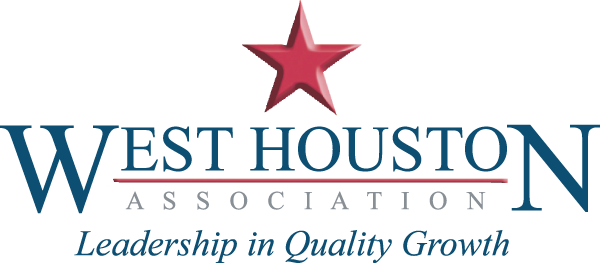The second panel of our 2025 Quality Planned Development (QPD) Symposium brought together leaders from healthcare, education, and land planning to explore a core question for the region’s continued success: How do we build communities that are not just livable, but equitable, connected, and resilient?
Moderated by Leslie Cook of RBC Capital Markets and WHA Vice Chair of the Education and Workforce Committee, the conversation framed robust communities as places where health, education, and design intersect, and where public and private sector leaders work together to anticipate the needs of a growing, diverse population.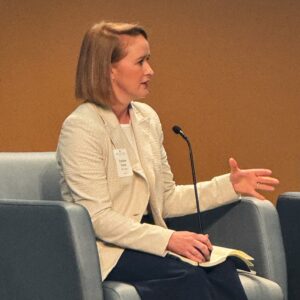
Leslie Cook opened the panel by spotlighting equity as a necessary lens for planning. Whether in healthcare, transportation, or access to education, equitable outcomes require intentional design. Ernesto Alfaro, Principal Planner at LJA Engineering, acknowledged the challenge of embedding equity in private-sector land planning, where the client is often a developer rather than the public. Still, he emphasized an ethical responsibility to consider access and inclusion through design, particularly by creating “third spaces”—parks, schools, and other public gathering areas that allow communities to come together and connect.
These third spaces, Alfaro explained, provide opportunities for building social capital and community identity—what he referred to as the “authenticity” that distinguishes one community from another. Spark Parks, a City of Houston initiative that opens school playgrounds to the public after hours, served as a standout example of equity in action.
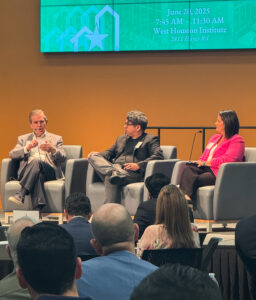 Dr. Zachary Hodges, President of HCC Northwest College, described education as central infrastructure. With HCC’s recent name change to Houston City College and the addition of bachelor’s degree programs in fields like healthcare management and AI, the institution is evolving to meet the demands of Houston’s 21st century workforce. Hodges pointed to the college’s partnership with University of Houston at Katy, as an example of how higher education institutions are embedding themselves with communities and providing “cradle to career” pathways.
Dr. Zachary Hodges, President of HCC Northwest College, described education as central infrastructure. With HCC’s recent name change to Houston City College and the addition of bachelor’s degree programs in fields like healthcare management and AI, the institution is evolving to meet the demands of Houston’s 21st century workforce. Hodges pointed to the college’s partnership with University of Houston at Katy, as an example of how higher education institutions are embedding themselves with communities and providing “cradle to career” pathways.
“Education is a lifelong process,” Hodges said. “And developers can no longer afford to think of schools only as elementary or high schools. Higher education has a place in the design and success of new developments.”
Kara Abrameit, Vice President of Texas Children’s Hospital West Campus, discussed how the healthcare system has evolved to serve families where they live. Texas Children’s has spent nearly two decades embedding services in West Houston, guided by both population data and direct community input. Abrameit emphasized the importance of preventative care and access, especially for uninsured or underinsured families, and the shift toward decentralized, outpatient care models.
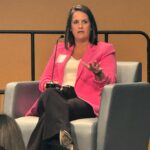 “Our Community Cares program brings not just medical care, but social services and behavioral health into neighborhoods where the need is greatest,” she explained. “We use data to determine what services are needed and where, but we also ask people directly: What’s missing in your community?”
“Our Community Cares program brings not just medical care, but social services and behavioral health into neighborhoods where the need is greatest,” she explained. “We use data to determine what services are needed and where, but we also ask people directly: What’s missing in your community?”
The hospital system has also prioritized transportation, including ride coordination for families without vehicles as well as free parking, and has embraced telehealth to make care more accessible outside of traditional hours. Abrameit noted that a child’s health trajectory can impact societal outcomes for decades, making early and equitable access to care an investment in the region’s long-term success. Throughout the conversation, panelists returned to a common theme: building communities for tomorrow requires creativity, collaboration, and a willingness to rethink outdated assumptions.
Alfaro pointed to changing household dynamics and the rise of multigenerational living as design drivers that could reshape everything from home construction to land use. “Master-planned communities take decades to build,” he noted. “And people’s habits, technologies, and expectations are shifting faster than ever.”
Abrameit echoed this, saying that health systems no longer have the luxury of simply reacting to demand. Instead, they must forecast future disease burdens, plan for demographic shifts, and ensure space to grow as neighborhoods evolve. Hodges emphasized that educators and employers alike must expand how they think about career pathways—and the built environments that support them.
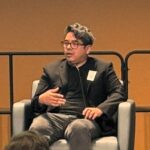
“The most dangerous thing we can do is underestimate how fast things are changing,” Hodges warned. “Whether it’s the rise of AI, new forms of education delivery, or access to broadband, we need to design with agility and imagination.”
Perhaps the most compelling call to action came in the final minutes of the panel: collaboration across sectors is no longer optional. Whether it’s a developer working with a community college to bring training facilities onsite, or a hospital designing flexible community classrooms for health education, panelists agreed that intentional partnerships are key. 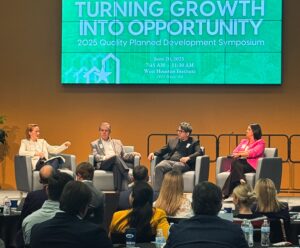
“We all have a vested interest in making our communities work,” said Hodges. “And we can’t think in traditional funding models anymore. We need new mechanisms, like public-private
partnerships, to finance the infrastructure of tomorrow.”
Panelists also discussed the importance of “intersectionality.” Recognizing how health, transportation, education, and planning all affect each other. “The data is there,” said Alfaro. “We just need new eyes to look at it.”
As the Houston region is expected to surpass 10 million residents by 2050, the stakes for building complete communities have never been higher. From the creative integration of education and healthcare into neighborhoods to ensuring access to transportation and technology, the West Houston region is uniquely positioned to lead.
The conversation made clear that quality planned development must go beyond zoning maps and design guidelines. It must include the human experience—how people live, learn, heal, and connect. And above all, it must be collaborative.
As Cook noted in closing, “We all seem to have the same vision. Now it’s time to make sure our actions align with it.”
